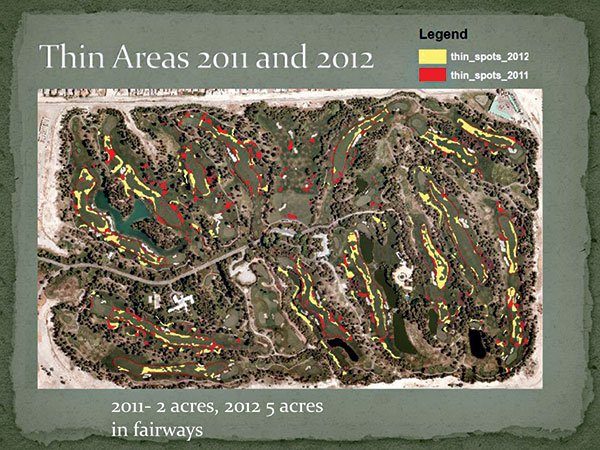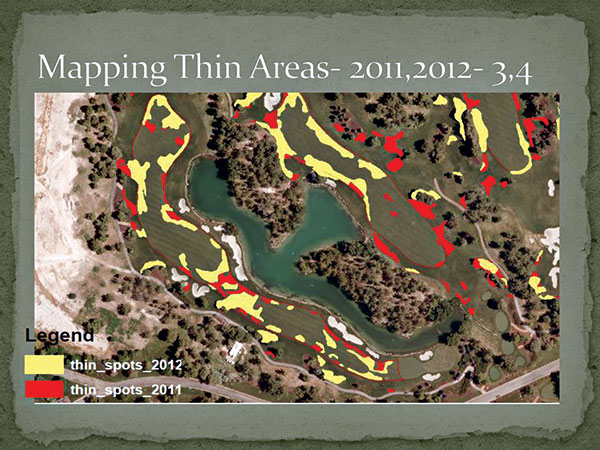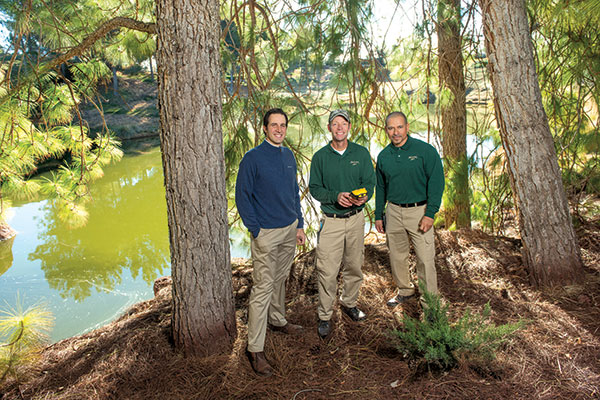The Shadow (Creek) superintendent knows

Photo: Jacob Kepler
Through diligent mapping and research, Shadow Creek Superintendent Tim Cloninger discovered that a bermudagrass decline problem was caused by insufficient irrigation. So how did he then reduce his water usage by 40 percent?
The City of North Las Vegas has changed out the water meter at Shadow Creek Golf Course the last four years in a row. They think something is wrong. Shadow Creek General Manager Monte Montgomery knows it’s the opposite: something is right.
“For the five years Timmy has been out here, he has just turned the place around, night and day,” says Montgomery, beaming with pride upon learning that his colleague, who he says is like a brother, is Golfdom’s 2017 Herb Graffis Businessperson of the Year award winner. “It’s scary what you can do when you have a good leader like Tim.”
In the six years of the Graffis award, Shadow Creek — designed by Tom Fazio in 1990 and owned by MGM Resorts International — is the highest profile course to employ the Graffis winner. But the award is not for its ranking among golf courses (currently No. 26 in Golf Digest’s top 100 courses), rather for the business savvy of its superintendent, 34-year-old Tim Cloninger.
“(Cloninger) has done things I’ve never seen before,” says Brian Whitlark, USGA Green Section agronomist for the West. “His work is phenomenal. He manages the course with the mindset that he wants to provide as good of playing conditions as possible year-round while minimizing inputs. People are under the impression that Shadow Creek has an unlimited budget… I think people would be surprised to hear that Tim has managed his resources very sparingly.”
Good advice

Owned by MGM International, Shadow Creek hosts high-roller golfers from around the world. That’s why General Manager Monte Montgomery says expectations for conditions are so high. “For Tim’s job we expect the best, and he outshines every superintendent I have ever been around.” (Photo: The Henebrys)
Born and raised in St. Louis, Mo., Cloninger had no interest in golf until he tore his ACL playing baseball as an 8th grader. Too young to have the ligament repaired, he decided to try out for the golf team because it was one sport he could still play.
He made the team. The ACL tear led him to a passion for the game, and eventually a career in the golf course industry.
A high school guidance counselor (and friend of his mom’s) introduced him to Missouri-based golf course architect Keith Foster. Foster got him his first job on a golf course, working maintenance for Forest Hills CC in Chesterfield, Mo. Foster later recommended Cloninger go to the University of Arizona to study under David Kopec, Ph.D.
“(Foster) was the one who told me about the golf industry and explained the different jobs,” Cloninger recalls. “He started out as a superintendent. I told him the greenskeeping side is what interested me. I didn’t know him that well — I only talked to him a couple times — but I always followed his advice.”
Cloninger says he was fortunate to work for good superintendents throughout his career, guys like Dave Nichols and Scott Reynolds. While at Arizona he did a three-month internship in Australia. He also worked with Kopec at U of A’s Karsten Turfgrass Research Facility.
“(Cloninger) was a student who always wanted to know the ‘why’ on top of the ‘how,’” says Kopec today. “He’s always impressed me with his computer skills and his ability to keep up with technologies. He doesn’t use them just because it’s there… he uses it because he knows he can get a benefit. He’s at the top of his game.”
Long haul in a U-Haul
Upon graduation from Arizona in 2004, Cloninger began working as an assistant superintendent in Las Vegas, first at Red Rock CC, then Shadow Creek. After four years, he decided it was time to try something else — a golf course had been his main place of employment since age 16. He went to graduate school at Arizona and earned two graduate certificates: one in Geographic Information Science (GIS) mapping and the other in Water Policy.
“I felt stagnant, I needed to learn something new,” Cloninger says. “The longer I was in school, the more I missed golf. But I’m glad I focused in precision agriculture-type applications, because it all came full circle. I was able to turn that into golf course management use.”
With an advanced education and a longing to get back into golf, he moved to Mexico to work for a management company as a construction superintendent. The next job took him to the Cayman Islands. After a few years, he took a job with a management company in Los Angeles to be close to his then girlfriend, now wife, Andrea.
It was the summer of 2011. Cloninger had just accepted a superintendent position in northern California when Shadow Creek called.
“The superintendent job had opened up, and they wanted to know if I would like to throw my hat in. I said yes, but I told them I just took a job that started soon and asked if I could interview right away,” Cloninger says. “They said, ‘Yeah, come over tomorrow.’ I got in the car and drove from Los Angeles to Las Vegas the next day and thought, ‘who knows?’”
Two days later he and Andrea were packed up and driving north toward Redding, Calif., when his cell phone rang. The caller ID read Shadow Creek. He gave Andrea a knowing look as he pulled the U-Haul over. They were six-and-a-half hours into an eight-hour trip. And just like that, a new eight-hour trip began. They turned around and went back the way they had just come, to Las Vegas, Shadow Creek and the beginning of a new chapter.
Shadow Creek’s concern
Shadow Creek underwent a complete renovation in 2008 to lengthen the course and rebuild the greens. The fairways were sand capped at the time to help battle bermudagrass decline on fairways, which had been a consistent struggle. Consultants suggested it was high salinity causing the problem and advised the fairways be capped with 6 inches of coarse sand and sodded. That fall, the fairways were allowed to go dormant to establish a strong rhizome base without the influence of a perennial ryegrass overseed.

Before and after, hole No. 6. On the left, an example of the bermudagrass decline that plagued Shadow Creek for years. On the right, the same hole after Cloninger mapped, analyzed and properly diagnosed the root of the problem. (Photo: Tim Cloninger)
Only three years later and after only one season of overseeding, it was clear the bermudagrass decline problem wasn’t improving. But now it was Cloninger’s problem. To solve this mystery, he went back to his academic training.
“The first time I went there he was very concerned with the lack of the bermudagrass in the fairways, so he mapped all the bermudagrass areas very accurately,” recalls the USGA’s Whitlark. “He had identified where there was good bermudagrass and where there was weak bermudagrass — even though it was buried under ryegrass — because he had mapped it with GIS.”
After taking numerous soil probes, Cloninger’s initial hypothesis was that thatch and black layer were causing the turf to hold too much water. The ryegrass was hanging on and keeping nearly 10 acres of bermudagrass from thriving in the summer.
“He started mapping the course’s soil moisture using a handheld TDR,” Whitlark says. “Most courses are using those today, but on greens. Tim brought it out to the fairways.”
Cloninger’s collection of data from multiple years proved his hypothesis wrong. It was in the dry areas where bermudagrass decline was prevalent. The data pinpointed not black layer, but part-circle irrigation heads that run along the fairway/rough border — they weren’t throwing sufficient water on fairway edges.

(Photo: Tim Cloninger)
Cloninger used his education in GIS mapping to create aerial maps of where bermudagrass decline was hitting each year. “What happened over the years, what the data showed, was the bermuda was declining in the dry areas, not the wet areas,” Cloninger says. “This showed a trend of the opposite of what agronomically you would think. The hypothesis was wrong.”

(Photo: Tim Cloninger)
Now that Cloninger had a cause, it was time to find a solution. He knew he needed a clean slate, so he developed a plan to sod three to four fairways a year, then let them go dormant. He convinced the GM to close the course during the four hottest weeks of the summer to get the job done. And he also started using a topmaker to aggressively remove the top layer of turf and thatch each summer. He found a sod from West Coast Turf in northern California that more closely matched the sand cap. And, of course, he adjusted the irrigation run rates along the edges of the fairways.
The results are now easily seen from every tee, and Shadow Creek’s high-roller clientele is as happy with the results as they would be hitting 21 at the blackjack table.
“We have high-end golfers from all over the world play here,” Montgomery says. “Tim’s job is one where we expect the best; perfect bunkers, cart paths trimmed, you name it. He’s a perfectionist.”
For Cloninger, it wasn’t about perfection, but survival.
“Before, the goal was simply to have fairways that were alive and playable. You had to sod them and do all this patchwork,” Cloninger says. “We’re sustainable now with the bermuda on the fairways. We were replacing the fairways every five years on average — we never had good fairways because we were replacing them, losing them, replacing them again. Plus, we were using so much of our labor hours on it, it was eating up our staff. Now that we’re not doing any sodding, we’ve got time to do other projects — like the irrigation on trees.”
Save the trees
So, if Cloninger increased his irrigation on fairways edges, how then has he reduced the water usage by 40 percent?
It started out as another GIS mapping project and grew into something much bigger. Cloninger wanted to create a tree management program for the course. He wanted to know the exact number of trees on the course and determine why 200 to 300 were dying every year. He also wanted to create a formal tree replacement program.
“We have just under 7,000 trees and we were losing between 200 and 300 a year,” Cloninger says. “Do the math on that — 10 years from now, if we don’t have a replacement program, what’s the course going to look like?”

Cloninger with Brad Harper, who did much of the fieldwork mapping fairways using a Trimble Geo Explorer XH 6000 (in hands) and Carlos Duran, who navigated the drip irrigation project. (Photo: Jacob Kepler)
Longtime Shadow Creek employee Brad Harper took on the Herculean task of mapping and tagging every tree on the property. A consulting arborist helped determine that 200 to 300 lost trees a season was to be expected because many were not properly planted at the time of construction, and some were just showing their age.
Brian Vinchesi, design engineer for Massachusetts-based Irrigation Consulting Inc., has been consulting with Shadow Creek for 15 years. He says the system that was in place for irrigating the trees — a traditional above-ground rotor system — was not ideal.
“(Trees) were getting a lot of overspray and being watered on a schedule that was good for whatever was under the tree,” Vinchesi says, “instead of what was good for the tree.”
Cloninger, Vinchesi and the arborist put their heads together and came up with a plan: install drip irrigation on all 7,000 trees, do the entire project in-house and save the trees while saving a bunch of water and money along the way.
In April of 2016, after chipping away at the project for two years, they installed the final drip irrigation line. And while the course invested significant money in the project, it paid for itself and then some. For every $1 invested in the project, the course saved more than $3 in water costs. Plus, fewer trees are dying: fewer than 150 trees lost in 2016, with the number continuing to trending down.
“MGM International has gone green, everything we do now, they have us saving water, reducing our garbage, using less paper,” says Montgomery. “We know the water costs in this town are only going up. So, what can we do? Tim and his team came up with this plan and did every tree themselves. When you work with someone like this, and you get these results? It makes my job so much easier.”
Vinchesi visited Shadow Creek in December to check on the results of the drip irrigation project. He jokes that he is about out of improvements he can help make for the course, and he’s fine with that.
“Tim’s a little different than most — he’s highly educated, especially on the water side. Between his drip irrigation and his soil-moisture measuring program, he has been able to fine-tune his watering schedule very specifically,” Vinchesi says. “Plus, Carlos (Duran), their irrigation manager, is really sharp. They’re saving a huge amount in water savings, both the water costs and also electrical pumping savings.”
When asked about the work of Duran, Cloninger lights up. He says his irrigation manager and his crew deserve all the credit for the success of the drip irrigation project.
“Carlos deserves so much credit — he runs the central control and came up with all the plans to install the drip,” Cloninger says. “We finished the project in April, just chipped away at it, three or four guys dedicated to it, not full-time but as we could get to it. They worked long and hard on the project, for not a lot of recognition.”
A very good year
In time, Cloninger may look back and consider 2016 the best year of his life. There was virtually no dead bermudagrass at Shadow Creek last season, something no one would have imagined a few years ago. The drip irrigation project was finished. He went back to school, this time to the University of Nebraska, and earned a Masters in Agronomy. And most exciting, he and Andrea became parents when son Owen was born Nov. 5.
Mild-mannered is a good way to describe Cloninger — he isn’t likely to get too worked up about anything outside of an Arizona Wildcats Final Four appearance — but his colleagues recognize the good work he’s done.
“More and more superintendents are using the technologies he’s utilizing,” Arizona’s Kopec says, “but he’s one of the top superintendents in the nation in the way he understands the benefits and what you can and can’t get out of it.”
Bill Kreuser, Ph.D., University of Nebraska-Lincoln, agrees with Kopec, and says that while more superintendents are going high-tech, Cloninger takes it to another level.
“Tim is able to step back from the problem and assess it from different angles and test out if his thoughts and conclusions are correct,” Kreuser says. “He had these issues on his golf course, he thought, ‘How can I use this technology with moisture meters and quantitatively monitor how things are changing over time?’ He changed his irrigation with the tools he was given. It wasn’t just living in the moment. He was collecting data, analyzing data and then changing his management as a result.”
For Cloninger, it’s simply doing the right thing.
“Environmentally it’s the right thing to do, and financially it’s a huge savings,” Cloninger says. “I give credit to the staff. They’ve been there a long time. I’ve taken a lot of their ideas. They know what works and what doesn’t work.”










